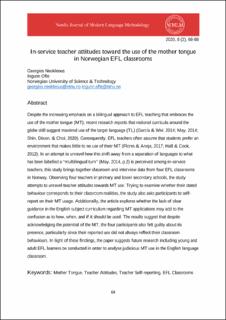| dc.contributor.author | Neokleous, Georgios | |
| dc.contributor.author | Ofte, Ingunn | |
| dc.date.accessioned | 2021-01-27T07:47:22Z | |
| dc.date.available | 2021-01-27T07:47:22Z | |
| dc.date.created | 2020-11-26T13:37:27Z | |
| dc.date.issued | 2020 | |
| dc.identifier.citation | Nordic Journal of Modern Language Methodology. 2020, 8 (2), 68-88. | en_US |
| dc.identifier.issn | 1894-2245 | |
| dc.identifier.uri | https://hdl.handle.net/11250/2724887 | |
| dc.description.abstract | Because of the lack of research on the use of the mother tongue (MT) in the English as a foreign language (EFL) classroom in European contexts, and because the topic is rarely discussed in teacher training programs, teachers often assume that students prefer an environment that makes little to no use of their MT. What complicates matters further is that while policy makers suggest maximal use of the target language (TL), European curricula for English as a subject do not contain any direct statements prescribing English as the sole language of instruction. Thus, EFL teachers who share an MT with their students often wonder to what extent and in what contexts they should employ the TL and MT. Observing four Norwegian EFL teachers in primary and lower secondary school over several lessons, this study attempts to unravel teacher attitudes towards MT use in the EFL classroom by presenting interview findings for the first time in a Norwegian setting. Additionally, the study explores whether the lack of clear guidance in the Norwegian curriculum for the subject of English regarding the use of the MT may add to the confusion among Norwegian EFL teachers as to how, when, and if the MT should be used. The results suggest that despite acknowledging the potential of the MT in the classroom, the four participants also felt guilty about its presence in their classrooms, particularly since their reported behaviours did not reflect their actual behaviours. In light of these findings, this paper suggests future research to shed light on what ratio would qualify as judicious MT use. It also highlights the importance of discussing the use of MT in EFL teacher training programs. | en_US |
| dc.language.iso | eng | en_US |
| dc.publisher | Department of Foreign Languages and Translation, UIA | en_US |
| dc.rights | Navngivelse 4.0 Internasjonal | * |
| dc.rights.uri | http://creativecommons.org/licenses/by/4.0/deed.no | * |
| dc.title | In-service teacher attitudes toward the use of the mother tongue in Norwegian EFL classrooms | en_US |
| dc.type | Peer reviewed | en_US |
| dc.type | Journal article | en_US |
| dc.description.version | publishedVersion | en_US |
| dc.source.pagenumber | 68-88 | en_US |
| dc.source.volume | 8 | en_US |
| dc.source.journal | Nordic Journal of Modern Language Methodology | en_US |
| dc.source.issue | 2 | en_US |
| dc.identifier.doi | 10.46364/njmlm.v8i2.436 | |
| dc.identifier.cristin | 1852920 | |
| dc.description.localcode | © 2020 The Authors. This is an open access article under the CC BY license (http://creativecommons.org/licenses/by/4.0/). | en_US |
| cristin.ispublished | true | |
| cristin.fulltext | original | |
| cristin.qualitycode | 1 | |

